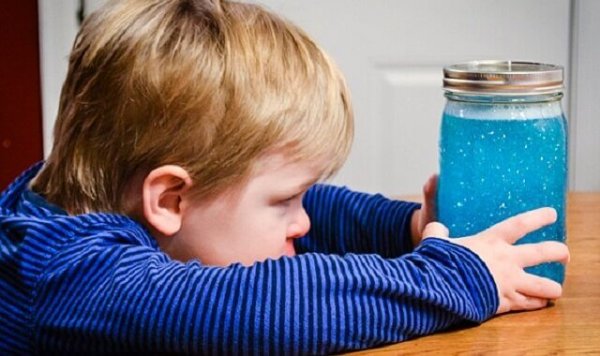The Calm Down Jar: A Glittery, Sensory Toy to Settle Down Your Child


Reviewed and approved by the psychologist Sergio De Dios González
Does your child throw tantrums? Do they feel anxious a lot? Sometimes parents or guardians are overwhelmed because they don’t know what tools to use to deal with situations like these.
That’s why today we’ll discover a very suitable technique for these cases: the calm down jar.
The calm down jar is a technique designed by Maria Montessori, pedagogue and educator, who also devoted her attention and effort to many other interests.
Her main objective was to design a method to help little ones have fun while learning. To do this, she focused on different activities to help children relate to their emotions.
Currently, schools don’t really teach children how to deal with their emotions well.
The calm down jar, a technique for parents too
The calm down jar isn’t applicable only to children, but also parents and other adults. We have a hard time dealing with our emotions, managing them properly, understanding them and expressing them. Therefore, trying this technique out could be good for a lot of us.
The calm down jar is nothing more than a transparent container, whether glass or plastic, where you put glitter, water, glue and coloring.
It’s best to let the child choose the color of the glitter and let them make their own calm down jar. Here is a video on how to make it:
Calm down jars are effective for children, adolescents and adults alike. However, after using it, we need to explain why we use it.
The goal is to use the calm down jar when children are angry. Its colors and the moving glitter will settle them down, forget what has caused their tantrum for a moment, and then they can talk about it much more easily.
This technique is not a new form of punishment
Parents might believe this technique is a new form of punishment. Just liking sending children to a corner if they do something wrong.
However, that’s not the purpose here. After you use the calming jar, the situation has deescalated. Then, you have to talk to them and help them express what they were feeling.
Why were they angry? What led them to feel so upset? When emotions are boiling over we can’t think clearly.
But once we calm down, we can see the situation from a calmer and less radical perspective. This way we’ll realize that, perhaps, we overreacted.
This is what we want children to understand by using the calm down jar. This positive technique will teach them to deal with their emotions more effectively.
They will stop acting so impulsively, instead giving themselves time to calm down and then analyze clearly what has happened.

The key here lies in the time that parents dedicate to their children: it has to be enough for them to internalize and learn this technique effectively.
Sitting with them, guiding them during the process of observing the calming jar and, subsequently, helping them express their emotions is very important.
Children often don’t know what emotion they’re feeling, why they’re feeling it, what it’s called, why it’s there and what its purpose is. It is the parents’ responsibility to teach them all this and guide them in good emotional expression.
The truth is that many adults also have problems identifying and expressing their emotions. Therefore, this technique can be very helpful for both parents and children.
It is mutual learning that everyone can benefit from and that will allow both the smallest and the largest to grow and improve their emotional management.
Does your child throw tantrums? Do they feel anxious a lot? Sometimes parents or guardians are overwhelmed because they don’t know what tools to use to deal with situations like these.
That’s why today we’ll discover a very suitable technique for these cases: the calm down jar.
The calm down jar is a technique designed by Maria Montessori, pedagogue and educator, who also devoted her attention and effort to many other interests.
Her main objective was to design a method to help little ones have fun while learning. To do this, she focused on different activities to help children relate to their emotions.
Currently, schools don’t really teach children how to deal with their emotions well.
The calm down jar, a technique for parents too
The calm down jar isn’t applicable only to children, but also parents and other adults. We have a hard time dealing with our emotions, managing them properly, understanding them and expressing them. Therefore, trying this technique out could be good for a lot of us.
The calm down jar is nothing more than a transparent container, whether glass or plastic, where you put glitter, water, glue and coloring.
It’s best to let the child choose the color of the glitter and let them make their own calm down jar. Here is a video on how to make it:
Calm down jars are effective for children, adolescents and adults alike. However, after using it, we need to explain why we use it.
The goal is to use the calm down jar when children are angry. Its colors and the moving glitter will settle them down, forget what has caused their tantrum for a moment, and then they can talk about it much more easily.
This technique is not a new form of punishment
Parents might believe this technique is a new form of punishment. Just liking sending children to a corner if they do something wrong.
However, that’s not the purpose here. After you use the calming jar, the situation has deescalated. Then, you have to talk to them and help them express what they were feeling.
Why were they angry? What led them to feel so upset? When emotions are boiling over we can’t think clearly.
But once we calm down, we can see the situation from a calmer and less radical perspective. This way we’ll realize that, perhaps, we overreacted.
This is what we want children to understand by using the calm down jar. This positive technique will teach them to deal with their emotions more effectively.
They will stop acting so impulsively, instead giving themselves time to calm down and then analyze clearly what has happened.

The key here lies in the time that parents dedicate to their children: it has to be enough for them to internalize and learn this technique effectively.
Sitting with them, guiding them during the process of observing the calming jar and, subsequently, helping them express their emotions is very important.
Children often don’t know what emotion they’re feeling, why they’re feeling it, what it’s called, why it’s there and what its purpose is. It is the parents’ responsibility to teach them all this and guide them in good emotional expression.
The truth is that many adults also have problems identifying and expressing their emotions. Therefore, this technique can be very helpful for both parents and children.
It is mutual learning that everyone can benefit from and that will allow both the smallest and the largest to grow and improve their emotional management.
This text is provided for informational purposes only and does not replace consultation with a professional. If in doubt, consult your specialist.







